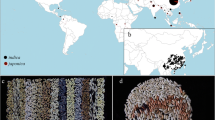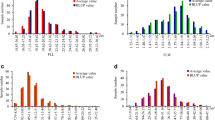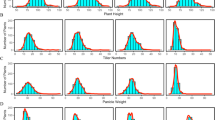Abstract
Heading date is one of the most important traits in wheat breeding as it affects adaptation and yield potential. A genome-wide association study (GWAS) using the 90 K iSelect SNP genoty** assay indicated that a total of 306 loci were significantly associated with heading and flowering dates in 13 environments in Chinese common wheat from the Yellow and Huai wheat region. Of these, 105 loci were significantly correlated with both heading and flowering dates and were found in clusters on chromosomes 2, 5, 6, and 7. Based on differences in distribution of the vernalization and photoperiod genes among chromosomes, arms, or block regions, 13 novel, environmentally stable genetic loci were associated with heading and flowering dates, including RAC875_c41145_189 on 1DS, RAC875_c50422_299 on 2BL, and RAC875_c48703_148 on 2DS, that accounted for more than 20% phenotypic variance explained (PVE) of the heading/flowering date in at least four environments. GWAS and t test of a combination of SNPs and vernalization and photoperiod alleles indicated that the Vrn-B1, Vrn-D1, and Ppd-D1 genes significantly affect heading and flowering dates in Chinese common wheat. Based on the association of heading and flowering dates with the vernalization and photoperiod alleles at seven loci and three significant SNPs, optimal linear regression equations were established, which show that of the seven loci, the Ppd-D1 gene plays the most important role in modulating heading and flowering dates in Chinese wheat, followed by Vrn-B1 and Vrn-D1. Additionally, three novel genetic loci (RAC875_c41145_189, Excalibur_c60164_137, and RAC875_c50422_299) also show important effect on heading and flowering dates. Therefore, Ppd-D1, Vrn-B1, Vrn-D1, and the novel genetic loci should be further investigated in terms of improving heading and flowering dates in Chinese wheat. Further quantitative analysis of an F10 recombinant inbred lines population identified a major QTL that controls heading and flowering dates within the Ppd-D1 locus with PVEs of 28.4% and 34.0%, respectively; this QTL was also significantly associated with spike length, peduncle length, fertile spikelets number, cold resistance, and tiller number.






Similar content being viewed by others
References
Ain Q, Rasheed A, Anwar A, Mahmood T, Imtiaz M, Mahmood T, **a X, He Z, Quraishi UM (2015) Genome-wide association for grain yield under rainfed conditions in historical wheat cultivars from Pakistan. Front Plant Sci 6:743
Alqudah AM, Sharma R, Pasam RK, Graner A, Kilian B (2014) Genetic dissection of photoperiod response based on GWAS of pre-anthesis phase duration in spring barley. PLoS ONE 9(11):e113120
Atwell S, Huang YS, Vilhjálmsson BJ (2010) Genome-wide association study of 107 phenotypes in Arabidopsis thaliana inbred lines. Nature 465:627–631
Beales J, Turner A, Griffiths S, Snape JW, Laurie DA (2007) A pseudo-response regulator is misexpressed in the photoperiod insensitive Ppd-D1a mutant of wheat (Triticum aestivum L.). Theor Appl Genet 115:721–733
Borner A, Worland AJ, Plaschke J, Schumann E, Law CN (1993) Pleiotropic effects of genes for reduced height (Rht) and day-length insensitivity (Ppd) on yield and its components for wheat grown in middle Europe. Plant Breed 111:204–216
Borrill P, Adamski N, Uauy C (2015) Genomics as the key to unlocking the polyploid potential of wheat. New Phytol 208:1008–1022
Brachi B, Faure N, Horton M, Flahauw E, Vazquez A (2010) Linkage and association map** of arabidopsis thaliana flowering time in nature. PLoS Genet 6(5):e1000940
Cane K, Eagles HA, Laurie DA, Trevaskis B, Vallance N, Eastwood RF (2013) Ppd-B1 and Ppd-D1 and their effects in southern Australian. Crop Pasture Sci 64:100–114
Cavanagh CR, Chao S, Wang S, Huang BE, Stephen S, Kiani S, Forrest K, Saintenac C, Brown-Guedira GL, Akhunova A (2013) Genome-wide comparative diversity uncovers multiple targets of selection for improvement in hexaploid wheat landraces and cultivars. Proc Natl Acad Sci 110:8057–8062
Chen A, Dubcovsky J (2012) Wheat TILLING mutants show that the vernalization gene VRN1 down-regulates the flowering repressor VRN2 in leaves but is not essential for flowering. PLoS Genet 8:e1003134
Chen F, Xu HX, Zhang FY, ** of puroindoline b-2 genes and molecular characterization of a novel variant in durum wheat (Triticum turgidum L.). Mol Breed 28:153–161
Chen F, Gao MX, Zhang JH, Zuo AH, Shang XL, Cui DQ (2013a) Molecular characterization of vernalization response and photoperiod response genes in bread wheat from the Yellow and Huai valley of China. BMC Plant Biol 13:199
Chen F, Zhang FY, Li HH, Morris CF, Cao YY, Shang XL (2013b) Allelic variation and distribution independence of Puroindoline b-B2 variants and their association with grain texture in wheat. Mol Breed 32:399–409
Diaz A, Zikhali M, Turner AS, Isaac P, Laurie DA (2012) Copy number variation affecting the Photoperiod-B1 and Vernalization-A1 genes is associated with altered flowering time in wheat (Triticum aestivum). PLoS ONE 7:e33234
Dubcovsky J, Lijavetzky D, Appendino L, Tranquilli G (1998) Comparative RFLP map** of Triticum monococcum genes controlling vernalization requirement. Theor Appl Genet 97:968–975
Dyck JA, Matus-Cadiz MA, Hucl P, Talbert L, Hunt T, Dubuc JP, Nass H, Clayton G, Dobb J, Quick J (2004) Agronomic performance of hard red spring wheat isolines sensitive and insensitive to photoperiod. Crop Sci 44:1976–1981
Eagles HA, Cane K, Kuchel H, Hollamby GJ, Vallance N, Eastwood RF (2010) Photoperiod and vernalization gene effects in southern Australian wheat. Crop Pasture Sci 61:721–730
Ellis MH, Bonnett DG, Rebetzke GJ (2007) A 192 bp allele at the Xgwm261 locus is not always associated with the Rht8 dwarfing gene in wheat (Triticum aesitvum L.). Euphytica 157:209–214
Faure S, Higgins J, Turner A, Laurie DA (2007) The flowering locus T-like gene family in barley (Hordeum vulgare). Genetics 176:599–609
Gawroński P, Ariyadasa R, Himmelbach A (2014) A distorted circadian clock causes early flowering and temperature-dependent variation in spike development in the Eps-3Am mutant of einkorn wheat. Genetics 196:1253–1261
Guo ZA, Song YX, Zhou R, Ren ZL, Jia JZ (2010) Discovery, evaluation and distribution of haplotypes of the wheat Ppd-D1 gene. New Phytol 185:841–851
Guo ZF, Chen DJ, Alqudah AM, Roder MS, Ganal MW, Schnurbusch T (2016) Genome-wide association analyses of 54 traits identified multiple loci for the determination of floret fertility in wheat. New Phytol 214:14342
Huang X, Wei X, Sang T (2010) Genome-wide association studies of 14 agronomic traitsin rice landraces. Nat Genet 42(11):961–967
Iqbal M, Shahzad A, Ahmed I (2012) Allelic variation at the Vrn-A1, Vrn-B1, Vrn-D1, Vrn-B3 and Ppd-D1a loci of Pakistani spring wheat cultivars. J Exp Bot 63:4419–4436
Kato K, Yamagata H (1988) Method for evaluation of chilling requirement and narrow-sense earliness of wheat cultivars. Jpn J Breed 38:172–186
Kippes N, Debernardi JM, Vasquez-Gross HA, Akpinar BA, Budak H, Kato K, Chao S, Akhunov E, Dubcovsky J (2015) Identification of the VERNALIZATION 4 gene reveals the origin of spring growth habit in ancient wheats from South Asia. Proc Natl Acad Sci 112(39):E5401–E5410
Law CN, Worland AJ (1997) Genetic analysis of some flowering time and adaptive traits in wheat. New Phytol 137:19–28
Lewis S, Faricelli ME, Appendino ML (2008) The chromosome region including the earliness per se locus Eps-Am 1 affects the duration of early developmental phases and spikelet number in diploid wheat. J Exp Bot 59:3593–3607
Li H, Ye G, Wang J (2007) A modified algorithm for the improvement of composite interval map**. Genetics 175:361–374
Li H, Peng Z, Yang X (2013) Genome-wide association study dissects the genetic architecture of oil biosynthesis in maize kernels. Nat Genet 45:43–50
Lipka AE, Tian F, Wang Q, Peiffer J, Li M, Bradbury PJ, Gore MA, Buckler ES, Zhang Z (2012) GAPIT: genome association and prediction integrated tool. Bioinformatics 28:2397–2399
Liu C, Chen HY, Er HL, Soo HM, Kumar PP, Han JH, Liou YC, Yu H (2008) Direct interaction of AGL24 and SOC1 integrates flowering signals in Arabidopsis. Development 135:1481–1491
Pritchard JK, Stephens M, Donnelly P (2000) Inference of population structure using multilocus genotype data. Genetics 7:574–578
Pugsley AT (1966) The photoperiodic sensitivity of some spring wheats with special reference to the variety Thatcher. Aust J Agric Res 17:591–599
Purcell S, Neale B, Todd-Brown K, Thomas L, Ferreira MAR, Bender D, Maller J, Sklar P, Bakker PIWD, Daly MJ (2007) PLINK: a tool set for whole-genome association and population-based linkage analyses. Am J Hum Gene 81:559–575
Strampelli N (1932) Early ripening wheats and the advance of Italian wheat production. Tipogr Faill 1933:5–7
Sun CW, Zhang FY, Yan XF, Zhang XF, Dong ZD, Cui DQ, Chen F (2017) Genome-wide association study for 13 agronomic traits reveals distribution of superior alleles in bread wheat from the Yellow and Huai Valley of China. Plant Biotechnol J 15:953–969
Tanio M, Kato K (2007) Development of near-isogenic lines for photoperiod-insensitive genes, Ppd-B1 and Ppd-D1, carried by the Japanese wheat cultivars and their effect on apical development. Breed Sci 57(1):65–72
Trevaskis B, Bagnall DJ, Ellis MH, Peacock WJ, Dennis ES (2003) MADS box genes control vernalization induced flowering in cereals. Proc Natl Acad Sci 100:6263–6268
Trevaskis B, Hemming MN, Peacock WJ, Dennis ES (2006) HvVRN2 responds to day length, whereas HvVRN1 is regulated by vernalization and developmental status. Plant Physiol 140:1397–1405
Turner A, Beales J, Faure S, Dunford RP, Laurie DA (2005) The pseudo response regulator Ppd-H1 provides adaptation to photoperiod in barley. Science 310:1031–1034
Uauy C (2017) Wheat genomics comes of age. Curr Opin Plant Biol 36:142–148
VanRaden PM (2008) Efficient methods to compute genomic predictions. J Dairy Sci 91:4414–4423
Wang S, Wong D, Forrest K, Allen A, Chao S, Huang BE, Maccaferri M, Salvi S, Milner SG, Cattivelli L (2014) Characterization of polyploid wheat genomic diversity using a high-density 90,000 single nucleotide polymorphism array. Plant Biotechnol J 12:787–796
Welsh JR, Keim DL, Pirasteh B, Richards RD (1973) Genetic control of photoperiod response in wheat. In: Sears ER, Sears LMS (eds) Proceedings of the 4th international wheat genetic symposium. University of Missouri Press, Columbia, pp 879–884
Wilhelm EP, Turner AS, Laurie DA (2009) Photoperiod insensitive Ppd-A1a mutations in tetraploid wheat (Triticum durum Desf.). Theor Appl Genet 118(2):285–294
Worland AJ, Börner A, Korzun V, Li WM, Petrovíc S, Sayers EJ (1998a) The influence of photoperiod genes on the adaptability of European winter wheats. Euphytica 100:385–394
Worland AJ, Korzun V, Roder MS, Ganal MW, Law CN (1998b) Genetic analysis of the dwarfing gene Rht8 in wheat. Part II. The distribution and adaptive significance of allelic variants at the Rht8 locus of wheat as revealed by microsatellite screening. Theor Appl Genet 96:1110–1120
Worland AJ, Sayers EJ, Korzun V (2001) Allelic variation at the dwarfing gene Rht8 locus and its significance in international breeding programmes. Euphytica 119:155–159
Wurschum T, Langer SM, Longin CF, Tucker MR, Leiser WL (2017) A modern green revolution gene for reduced height in wheat. Plant J 92:892–903
Yan L, Loukoianov A, Tranquilli G, Helguera M, Fahima T, Dubcovsky J (2003) Positional cloning of the wheat vernalization gene VRN1. Proc Natl Acad Sci 100:6263–6268
Yan L, Helguera M, Kato K, Fukuyama S, Sherman J, Dubcovsky J (2004) Allelic variation at the VRN-1 promoter region in polyploid wheat. Theor Appl Genet 109:1677–1686
Yan L, Fu D, Lin C, Blechl A, Tranquilli G, Bonafede M, Sanchez A, Valarik M, Dubcovsky J (2006) The wheat and barley vernalization gene VRN3 is an orthologue of FT. Proc Natl Acad Sci 103:19581–19586
Yang FP, Zhang XK, **a XC (2009) Distribution of the photoperiod insensitive Ppd-D1a allele in Chinese wheat cultivars. Euphytica 165:445–452
Yang N, Lu Y, Yang X, Huang J, Zhou Y (2014) Genome wide association studies using a new nonparametric model reveal the genetic architecture of 17 agronomic traits in an enlarged maize association panel. PLoS Genet 10(9):e1004573
Yano K, Yamamoto E, Aya K, Takeuchi H (2016) Genome-wide association study using whole-genome sequencing rapidly identifies new genes influencing agronomic traits in rice. Nat Genet 48:927–934
Yasuda S (1984) Comparative studies on the development of spike primordia between cultivars of common wheat and barley. BerOhara Inst Landw Biol Okayama Univ 18:211–225
Yu JM, Pressoir G, Briggs WH, Bi IV, Yamasaki M, Doebley JF, McMullen MD, Gaut BS, Nielsen DM, Holland JB (2006) A unified mixed-model method for association map** that accounts for multiple levels of relatedness. Nat Genet 38:203–208
Zanke CD, Ling J, Plieske J (2014) Genetic architecture of main effect QTL for heading date in European winter wheat. Front Plant Sci 5:217
Zhang Z, Ersoz E, Lai CQ, Todhunter RJ, Tiwari HK, Gore MA, Bradbury PJ, Yu J, Arnett DK, Ordovas JM (2010) Mixed linear model approach adapted for genome-wide association studies. Nat Genet 42:355–360
Zhang XF, Gao MX, Wang SS, Chen F, Cui DQ (2015a) Allelic variation at the vernalization and photoperiod sensitivity loci in Chinese winter wheat cultivars (Triticum aestivum L.). Front Plant Sci 6:470
Zhang JP, Song QJ, Cregan PB, Nelson RL, Wang XZ, Wu JX, Guo LL (2015b) Genome-wide association study for flowering time, maturity dates and plant height in early maturing soybean (Glycine max) germplasm. BMC Genom 16:217
Zhang N, Zhang LR, Zhao L, Ren Y, Cui DQ, Chen JH, Wang YY, Yu PB, Chen F (2017) iTRAQ and virus-induced gene silencing revealed three proteins involved in cold response in bread wheat. Sci Rep 7:7524
Zhuang QS (2003) Wheat improvement and pedigree analysis in Chinese wheat cultivars. China Agriculture Press, Bei**g
Acknowledgements
This project was funded by the National Key Research and Development Program (2016YFD0101802), Henan Major Science and Technology Projects (181100110200), and Henan Science and Technology Innovation Outstanding Youth Funding (174100510001) of China.
Author information
Authors and Affiliations
Corresponding author
Ethics declarations
Conflict of interest
The authors have no conflict of interest to declare.
Additional information
Communicated by Peter Langridge.
Electronic supplementary material
Below is the link to the electronic supplementary material.
Fig. S1A
Distribution frequency of heading date (1A) and flowering date (1B) of Chinese wheat cultivars in 13 environments (PNG 778 kb)
Fig. S1B
Supplementary material 2 (PNG 814 kb)
Fig. S2
Population structure of the selected 163 cultivars based on unlinked SNP markers. (A) Plot of delta K against putative K ranging from 1 to 10. (B) Stacked bar plot of ancestry relationship of 163 cultivars. (JPEG 68 kb)
Fig. S3A
Manhattan plots and Quantile–Quantile (Q–Q) plots for heading (3A) and flowering dates (3B). (JPEG 6025 kb)
Fig. S3B
Supplementary material 5 (JPEG 6157 kb)
Table S1
Heading and flowering dates in Chinese winter cultivars in 13 environments (XLSX 212 kb)
Table S2
Significant SNPs detected for heading and flowering dates through GWAS (A); Significant SNPs detected for heading date through GWAS (B); Significant SNPs detected for flowering date through GWAS (C); Significant SNPs detected for both heading and flowering dates through GWAS (D) (XLSX 77 kb)
Table S3
PCR primers used in this study (XLSX 13 kb)
Table S4
Allelic variations of the vernalization and photoperiod genes and heading and flowering dates in 2012-2013 and 2014-2015 years of 254 landraces. (XLSX 30 kb)
Table S5
The partial regression coefficient and P value in multiple regression equations in three populations (AMP, CWG, and CL) (XLSX 12 kb)
Table S6
Phenotype of seven traits of a PC population with 97 lines (XLSX 14 kb)
Rights and permissions
About this article
Cite this article
Zhang, X., Chen, J., Yan, Y. et al. Genome-wide association study of heading and flowering dates and construction of its prediction equation in Chinese common wheat. Theor Appl Genet 131, 2271–2285 (2018). https://doi.org/10.1007/s00122-018-3181-8
Received:
Accepted:
Published:
Issue Date:
DOI: https://doi.org/10.1007/s00122-018-3181-8




